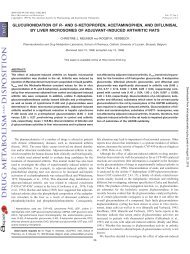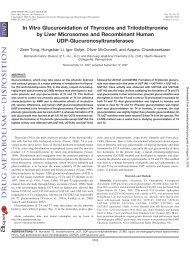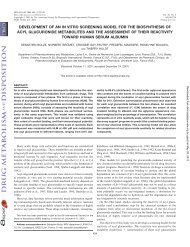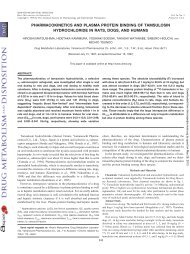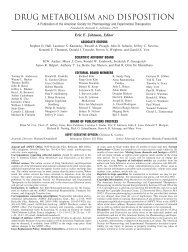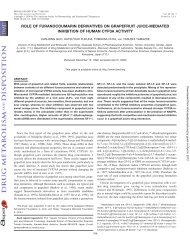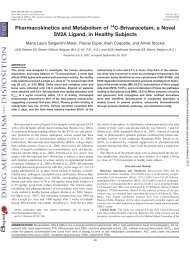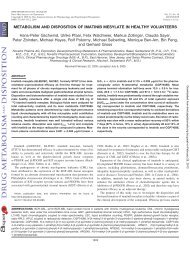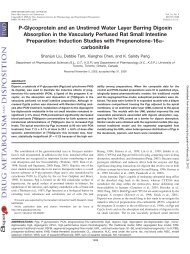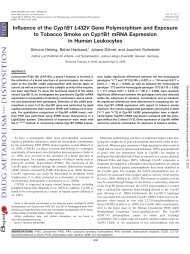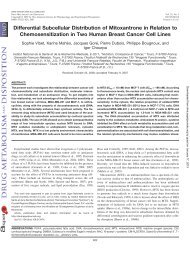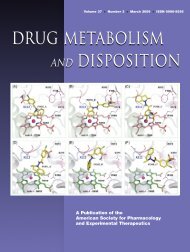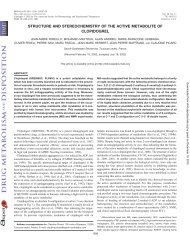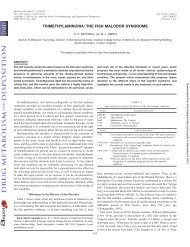metabolism of diallyl disulfide by human liver microsomal ...
metabolism of diallyl disulfide by human liver microsomal ...
metabolism of diallyl disulfide by human liver microsomal ...
Create successful ePaper yourself
Turn your PDF publications into a flip-book with our unique Google optimized e-Paper software.
840 TEYSSIER ET AL.<br />
TABLE 6<br />
Correlation between DADS oxidation and CYP is<strong>of</strong>orm specific activities in a<br />
panel <strong>of</strong> <strong>human</strong> <strong>liver</strong> microsomes<br />
Enzyme Activity CYP<br />
Correlation<br />
Coefficient (r)<br />
EROD 1A2 0.07<br />
COH 2A6 0.06<br />
TDH 2C9 0.52 a<br />
MpH 2C19 0.05<br />
DOD 2D6 0.05<br />
PNPH 2E1 0.63 b<br />
(�-1)LAH 2E1 0.40 c<br />
NfO 3A4 0.19<br />
(�)LAH 4A 0.07<br />
a p � .001, n � 33<br />
b p � .001, n � 25<br />
c p � .05, n � 26<br />
DADSO 2) that should interact with the enzyme and should not be<br />
released from the active site <strong>of</strong> the enzyme.<br />
Egen-Schwind et al. (1992) have studied the <strong>metabolism</strong> <strong>of</strong><br />
DADSO in a perfused rat <strong>liver</strong>. They observed that while passing<br />
through the <strong>liver</strong>, DADSO was metabolized to DADS. The discrepancy<br />
could be explained <strong>by</strong> the models that were used in both studies.<br />
They did not add NADPH during the <strong>liver</strong> perfusion. Due to the<br />
sensitivity <strong>of</strong> DADSO to temperature, a dismutation <strong>of</strong> DADSO in<br />
DADS could be possible. We observed the formation <strong>of</strong> DADS when<br />
DADSO was incubated with microsomes at 37°C without NADPH. In<br />
addition, Jin and Baillie (1997) studied the <strong>metabolism</strong> <strong>of</strong> DAS in rat.<br />
They proposed that the reduction <strong>of</strong> allyl sulfoxide to DAS was<br />
impossible with respect to the glutathione conjugates observed with<br />
rat fed with DAS or allyl sulfoxide.<br />
Flavin or CYPs are the only enzymes present in microsomes that<br />
can catalyze NADPH- and oxygen-dependent oxidation <strong>of</strong> xenobiotics.<br />
The inhibition <strong>of</strong> CYP <strong>by</strong> 1-aminobenzotriazole, a suicide inhibitor,<br />
as well as the irreversible inactivation <strong>of</strong> FMO <strong>by</strong> heating<br />
induced a decrease <strong>of</strong> the rate <strong>of</strong> DADS oxidation. Moreover, the<br />
DADS oxidation was observed with microsomes prepared from cells<br />
expressing <strong>human</strong> FMO3. These results suggest a contribution <strong>of</strong> both<br />
CYP and FMO-containing monooxygenases. Some results allow the<br />
evaluation <strong>of</strong> the FMO implication in this oxidation: its K m is much<br />
higher than the one obtained for FMOs associated with CYP in <strong>human</strong><br />
microsomes (10.15 versus 0.61 mM). The similar comparison made<br />
with cDNA-expressed isoenzymes gave 10.15 mM for FMO3 and<br />
0.03 mM for CYP2E1. When the incubation <strong>of</strong> microsomes and<br />
DADS was made in the presence <strong>of</strong> inhibited CYP, the DADS oxidase<br />
activity is very low, whereas when the FMOs were inactivated this<br />
activity was slightly decreased. Each <strong>of</strong> these results suggests that<br />
FMOs are less active than CYP in the <strong>metabolism</strong> <strong>of</strong> DADS. Nevertheless,<br />
to our knowledge, this is the first study that describes the<br />
implication <strong>of</strong> FMOs in the oxidation <strong>of</strong> sulfur compounds issued<br />
from garlic.<br />
Three approaches have been developed to identify the CYP isoenzymes<br />
involved in DADS oxidation. They were based on: 1) the use<br />
<strong>of</strong> cDNA-expressed CYP isoenzymes, 2) the use <strong>of</strong> selective chemical<br />
inhibitors, and 3) the study <strong>of</strong> the correlation <strong>of</strong> DADS oxidation<br />
activity with marker activities <strong>of</strong> CYP isoenzymes. Several pieces <strong>of</strong><br />
evidence indicate that CYP2E1 is the major cytochrome P-450 responsible<br />
for the metabolic process: 1) the rate <strong>of</strong> formation <strong>of</strong><br />
DADSO was substantially inhibited <strong>by</strong> the CYP2E1 inhibitors diethyldithiocarbamate<br />
and chlorzoxazone, 2) PNPH and (�-1)LAH activities<br />
(two marker activities <strong>of</strong> CYP2E1) in 25 individual <strong>human</strong> <strong>liver</strong><br />
microsomes exhibited the best correlation with the formation <strong>of</strong><br />
DADSO, and 3) with a K m <strong>of</strong> 0.03 mM and a V max/K m ratio <strong>of</strong> 2010<br />
calculated with cDNA-expressed CYP2E1, this isoenzyme exhibited<br />
the highest affinity and the highest intrinsic clearance among the<br />
is<strong>of</strong>orms tested. Even if the quantity <strong>of</strong> CYP2E1 in <strong>human</strong> microsomes<br />
was evaluated to 7% <strong>of</strong> whole CYP versus 18% for CYP2C and<br />
29% for CYP3A (Shimada et al., 1994), the relative involvement <strong>of</strong><br />
CYP2E1 is predominant.<br />
Nevertheless, our results suggest the involvement <strong>of</strong> other CYPs.<br />
Many isoenzymes, such as CYP2A6, CYP2C9, CYP2C19, CYP2D6,<br />
and CYP2E1 were able to oxidize DADS to DADSO. Their K m values<br />
showed that in a competitive context like in <strong>human</strong> microsomes, only<br />
CYP2E1 would be involved. The apparent velocity <strong>of</strong> CYP2E1 was<br />
not the highest one. We demonstrated that DADSO was a mechanismbased<br />
inhibitor <strong>of</strong> CYP2E1 (Martin, Teyssier and Siess, publication in<br />
preparation). This means that the more DADSO is produced, more<br />
CYP2E1 is inhibited. This observation may serve as an explanation<br />
for the low V max <strong>of</strong> CYP2E1.<br />
In the inhibitory experiments, tranylcypromine, an inhibitor described<br />
as being specific <strong>of</strong> CYP2C19 (Postlind et al., 1998), strongly<br />
inhibited DADS oxidase activity, suggesting the participation <strong>of</strong> this<br />
isoenzyme. However, the specificity <strong>of</strong> this inhibitor should be reconsidered<br />
because Draper et al. (1997) recently demonstrated that this<br />
molecule is among the strongest inhibitors <strong>of</strong> the coumarin hydroxylase<br />
activity (CYP2A6 activity marker), and we showed the PNPH<br />
activity inhibition <strong>by</strong> tranylcypromine. Therefore, CYP2C19 does not<br />
seem to be involved in DADS oxidation.<br />
DADS has a chemical structure similar to DAS; they differ only <strong>by</strong><br />
one sulfur atom. These two molecules are metabolized <strong>by</strong> CYP2E1<br />
and produce a mechanism-based inhibitor <strong>of</strong> CYP2E1. The <strong>metabolism</strong><br />
<strong>of</strong> DADS and its pathway is one more similarity between these<br />
two molecules issued <strong>of</strong> garlic.<br />
In conclusion, the oxidation <strong>of</strong> DADS to DADSO in <strong>human</strong> <strong>liver</strong><br />
microsomes is mainly mediated <strong>by</strong> CYPs but also <strong>by</strong> FMOs. Among<br />
the CYP isoenzymes, CYP2E1 seems to be the most involved isoenzyme<br />
even if a few other isoenzymes are also able to catalyze this<br />
reaction.<br />
Acknowledgments. We thank Jacques Auger for providing<br />
DADSO and Marie-France Vernevaut for her technical assistance.<br />
References<br />
Amet Y, Berthou F, Baird S, Dreano Y, Bail JP and Menez JF (1995) Validation <strong>of</strong> the<br />
(omega-1)-hydroxylation <strong>of</strong> lauric acid as an in vitro substrate probe for <strong>human</strong> <strong>liver</strong> CYP2E1.<br />
Biochem Pharmacol 50:1775–1782.<br />
Augusti KT (1996) Therapeutic values <strong>of</strong> onion (Allium cepa L) and garlic (Allium sativum L).<br />
Indian J Exp Biol 34:634–640.<br />
Baldwin SJ, Bloomer JC, Smith GJ, Ayrton AD, Clarke SE and Chenery RJ (1995) Ketoconazole<br />
and sulphaphenazole as the respective selective inhibitors <strong>of</strong> P4503A and 2C9. Xenobiotica<br />
25:261–270.<br />
Block E (1992) The organosulfur chemistry <strong>of</strong> the genus Allium. Implications for the organic<br />
chemistry <strong>of</strong> sulfur. Angew Chem Int Ed Eng 31:1135–1178.<br />
Bourrié M, Meunier V, Berger Y and Fabre G (1996) Cytochrome P450 is<strong>of</strong>orm inhibitors as a<br />
tool for the investigation <strong>of</strong> metabolic reactions catalyzed <strong>by</strong> <strong>human</strong> <strong>liver</strong> microsomes.<br />
J Pharmacol Exp Ther 277:321–332.<br />
Brady JF, Ishizaki H, Fukuto JM, Lin MC, Fadel A, Gapac JM and Yang CS (1991) Inhibition<br />
<strong>of</strong> cytochrome P-450 2E1 <strong>by</strong> <strong>diallyl</strong> sulfide and its metabolites. Chem Res Toxicol 4:642–647.<br />
Burke MD, Thompson S, Elcombe CR, Halpert J, Haaparanta T and Mayer RT (1985) Ethoxy-,<br />
pentoxy- and benzyloxyphenoxazones and homologues: A series <strong>of</strong> substrates to distinguish<br />
between different induced cytochromes P-450. Biochem Pharmacol 34:3337–3345.<br />
Cai Y, Baer-Dubowska W, Ashwood-Smith MJ, Ceska D, Tachibana S and Digiovanni J (1995)<br />
Mechanism based inactivation <strong>of</strong> hepatic ethoxyresorufin O-dealkylation activity <strong>by</strong> naturally<br />
occurring coumarin. Chem Res Toxicol 9:729–736.<br />
Chang T, Weber C, Crespi C and Waxman D (1993) Differential activation <strong>of</strong> cyclophosphamide<br />
and ifosphamide <strong>by</strong> cytochromes P450 2B and 3A in <strong>human</strong> <strong>liver</strong> microsomes. Cancer Res<br />
53:5629–5637.<br />
Chen L, Lee M, Hong JY, Huang W, Wang E and Yang CS (1994) Relationship between<br />
cytochrome P450 2E1 and acetone catabolism in rats as studied with <strong>diallyl</strong> sulfide as an<br />
inhibitor. Biochem Pharmacol 48:2199–2205.<br />
De Montellano O and Mathews JM (1981) Autocatalytic alkylation <strong>of</strong> the cytochrome P-450<br />
prosthetic haem group <strong>by</strong> 1-aminobenzotriazole. Isolation <strong>of</strong> an NN-bridged benzyneprotoporphyrin<br />
IX adduct. Biochem J 195:761–764.<br />
Dixit A and Roche TE (1984) Spectrophotometric assay <strong>of</strong> the flavin-containing monooxygenase<br />
Downloaded from<br />
dmd.aspetjournals.org <strong>by</strong> guest on November 24, 2012



